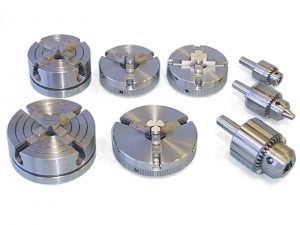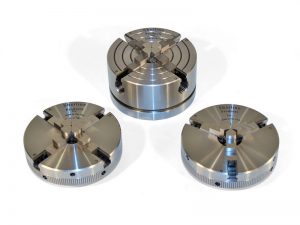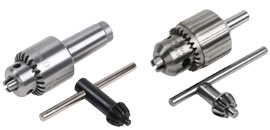
Scroll Chucks
3-Jaw Chucks
Three-jaw and four-jaw chucks offer a quick and convenient way to hold a workpiece while it is turned on the lathe. A chuck can also be clamped to a mill table to hold a part for milling. Drill chucks are used to hold drill bits. Sherline manufactures our own chucks to a high degree of precision on CNC machines. The jaws are ground and fitted to each chuck by skilled technicians to assure maximum accuracy.
The Sherline chucks above are available in 2.5″ and 3.1″ diameters. The jaws are reversible for a larger clamping range. Soft (unhardened) jaws are available as an option. Our chucks normally come with a 3/4-16 internal thread for use on Sherline spindles, but other threads are also available to fit different small machines.
Three-jaw chucks are normally used to hold round or hexagonal stock quickly. The jaws scroll together in unison as the knurled ring of the chuck is turned. Parts can be held quickly with relatively good accuracy. Runout is less than .003″.*
4-Jaw Chucks
Also available are self-centering 4-jaw chucks. They are adjusted like a 3-jaw chuck and can be used on round or square stock, although the stock must be accurate for all four jaws to grip properly. They can be used to hold square material quickly or to provide an extra jaw to spread out the crushing force when holding thin tubing. This chuck is available in both 2.5″ and 3.1″ diameters.
The Purpose and Use of a 4-Jaw Chuck
Independant Jaw Chucks
4-jaw independent jaw chucks have four advantages over a 3-jaw chuck.
- They can be used to hold irregularly shaped parts.
- With the use of a dial indicator, they can be used to center parts with a great deal of accuracy.
- 4-jaw chucks can be used to hold a part off center deliberately
- They can clamp stock in a tighter grip.
This is a valuable asset when machining cams, crankshafts and other similar parts. The disadvantage of the 4-jaw chuck is that the jaws must be individually set, adding considerable time to bar stock setups.
Although we recommend the purchase of the 3-jaw chuck to make the Models 4000A, 4400A or 4500A lathe easier to use for standard lathe projects, the 4-jaw chuck could be considered the accessory that could add the most versatility to your machine. However, if you have definite projects in mind where you feel the 4-jaw chuck would be more useful, or if you already own a 3-jaw chuck, the “A package” lathes may be ordered with the 4-jaw substituted for the 3-jaw upon special request.
Self-Centering Chucks
Self-centering chucks (or scroll chucks) will never duplicate the accuracy that can be attained with jaws that are moved independently, but they will usually “get the job done”, saving a machinist much time and effort. Its main purpose is to center and hold square or round stock quickly. The disadvantages are that the material must be quite accurately round or square for all four jaws to grip properly, and absolute centering accuracy cannot be achieved because the jaws cannot be individually adjusted. These are offered only in a 3/4-16 spindle thread to fit Sherline machines and are not available in metric threads for older Unimat and other brand machines.

ER-16 Chucks
For years Sherline has offered the option of specifying a headstock spindle nose that accepts ER-16 collets in place of the standard 3/4-16 thread and #1 Morse taper. The down side of using that spindle is that Sherline’s 3/4-16 threaded chucks can no longer be used. Now Sherline makes three new chucks that will thread onto the 22 x 1.5mm thread used for the ER-16 collet nut. The new chucks are
- P/N 1042 3.1″ 3-jaw self-centering chuck
- P/N 1078 3.1″ 4-jaw self-centering chuck
- P/N 1032 3.1″ 4-jaw independent chuck
Drill Chucks
Sherline’s drill chucks are made in the USA by Jacobs. We supply a #0 Morse arbor for use in the tailstock for center drilling. The chucks are also available with a #1 Morse arbor and drawbolt for use in the headstock for drilling on the lathe or mill. They are available in 5/32″, 1/4″ and 3/8″ sizes. Runout is .004″ or less. If runout of less than this amount is required, collets should be used to hold the drill rather than a chuck.
*NOTE: These chucks were designed to hold tolerances at a maximum rotation speed of 3000 RPM.
